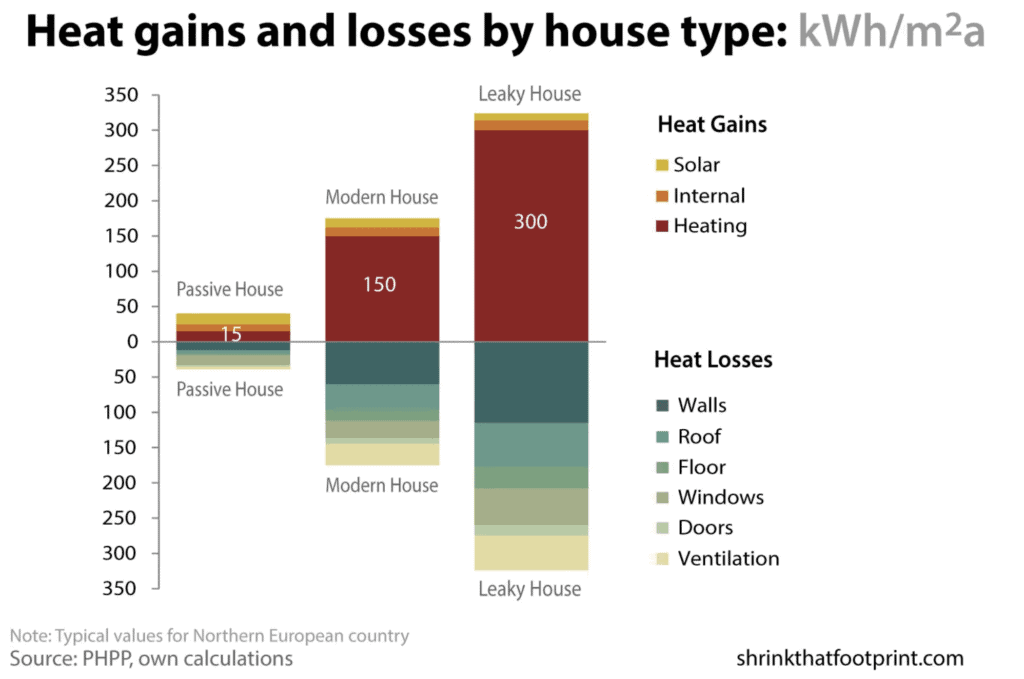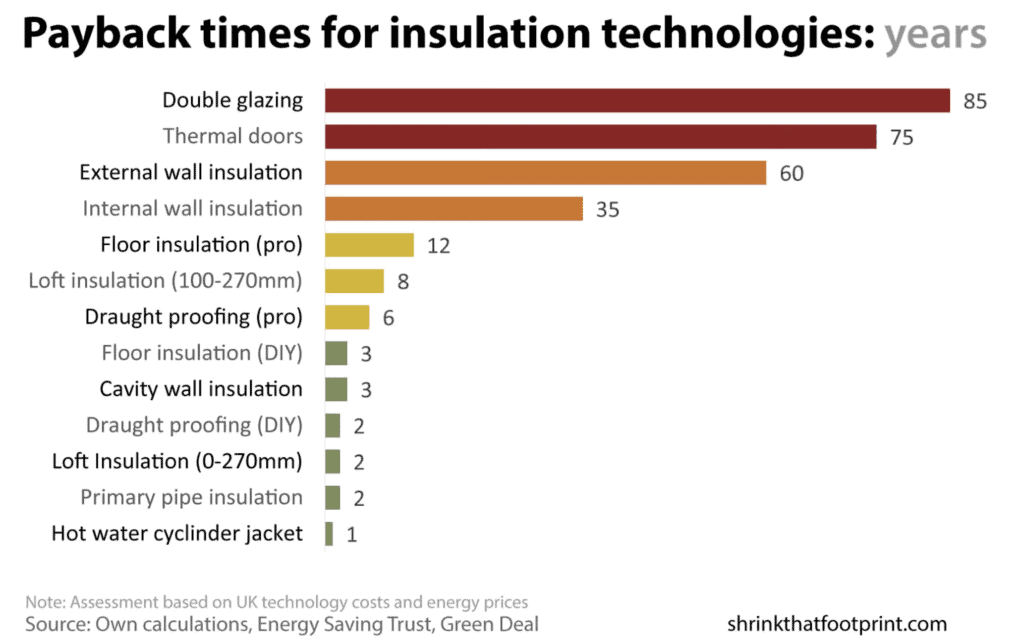Seal An Air Leak: How Improving Insulation Reduces Heating And Cooling Costs
We look at how your home’s heat loss affects it heating and cooling needs. While many of use just think in terms of heating bills it really helps to think about heat loss to work out the simplest ways to save money on our energy bills without reducing comfort. The discussion below is quite theoretical. If you want to know how to act on the information, take a look at our new guide about home insulation.
Heat Loss Or Cold Loss Is The Main Determinant Of Your Heating Or Cooling Costs
When you get your heating bill, it may be in units of natural gas use, electricity, or oil. But what’s really costing you is heat loss. Today we’re going to talk about some cheap and simple ways to draft-proof your home. But first up, let’s get to grips with heat loss. So, imagine that this is a house and this is the external temperature. It’s freezing.
And this is the internal temperature, which is 20 degrees centigrade or 68 degrees Fahrenheit. Now, if this was a perfectly insulated box, it would leak no heat, just like it is now. But all houses leak heat. Now, let’s imagine this is a super insulated passive house with great insulation and very low air leakage. Then it would only leak a little heat.
Modern Houses Leak 10 Times More Heat Than Passive Houses
If it was a modern house, it would leak a lot more heat – say five times. But if it was a really old, leaky house, it would leak 10 times as much. Now, for every bit of heat that the house leaks, that’s the heat that you need to put back into it to maintain the temperature. And the more that your house leaks, the more you have to spend on heating to keep your house warm. So that’s a pretty good description of how the rate of heat loss determines your heating needs.
The Routes Of Heat Loss Are The Walls, Roof, Windows and Ventilation
The heating needs of a passive house are much smaller than those of a typical modern home. Heat losses are typically less than 40 kilowatt hours per square meter each year, while for a typical modern home, they are normally more than 150 kilowatt hours per square meter. The main factors contributing to heat loss are the walls, roof, windows, and ventilation.

Passive Houses Leak 15 kWh Per Sq Meter Per Year; Modern Houses 10x More
Because houses remain roughly the same temperature over the course of the year, we know that the heat gains need to equal the heat losses for a passive house. The heat energy required from the heating system is just 15 kilowatt hours per square meter per year, while for a modern house it can be up to 10 times that – 150 kilowatt hours – and for the leaky house it’s a massive 300 kilowatt hours. Looking at the data like that, it’s really easy to think we should just all have passive houses, but in reality it’s more complicated than that. If you live in a cool climate and are ever lucky enough to build a new house, then going after a passive house certification or a really high level of energy efficiency is a really interesting idea.
Insulation Technologies Vary Widely In Investment Potential
Cost-effectively adding insulation technologies to an old house is a real art form because the payback of different technologies varies enormously. Some insulation technologies are very good investments because their energy savings pay back the costs within just a couple of years. These include insulating a hot water cylinder, insulating pipes and ducts, insulating an uninsulated loft, draught proofing your home, getting cavity wall insulation and doing your own floor insulation. Some things that are also a good investment but have a slower payback include having a professional do your draft roofing, topping up loft insulation and having floor insulation done professionally.

Internal And External Wall Insulation Has Low Pay Back
Fitting internal or external wall insulation is a great way to retrofit an old building, but because of its high cost it has relatively slow payback. Finally, adding thermal doors or having double glazing fitted can do wonders to improve the comfort of a home but is unlikely to pay you back in terms of energy savings in your lifetime. If you own your own home, it’s really worth looking at the loft cavity wall and floor insulation that you’ve got and seeing if it needs topping up. But even if you don’t own your own home, it’s worth looking into.
Caulk Wind-Proofs Your Windows
These five draught-proofing tips are something that we can all do on the cheap and easily to make a little difference. Caulking gaps is a really easy thing to do; if there’s going to be a lot of movement in the joint you want something with silicon and you simply drag it along, fill it in and then run your finger along to clean it out. Adding foam strips to external doorways is really easy to do; you just cut to the right size and stick it in. If you’ve got any big holes around external pipes or ducting you can use expanding foam like this; quite fun.
Take Care Of Fire Places To Reduce Heat Loss
Unused fireplaces are regularly forgotten source of heat loss. You can get a balloon that’s specific for this job but we just use an old duvet and I’ll do not wrap them in some plastic bags finally if you’re feeling brave blocking any gaps between floorboards on ground floors can really seal up a lot of heat loss and you can use a silicon sealant in our case we’ve just used sawdust and PVA. That’s it for today I hope you learned something for our installation if you’re not a homeowner and can’t do much with those insulation tips make sure you check this out tomorrow when we’re looking at heating controls.
Keep In Your AC In Good Shape
Regular maintenance of your air conditioner is essential for efficient cooling and lower energy bills. This includes changing your air filter every 1-3 months, cleaning the condenser coils, checking for refrigerant leaks, and keeping the area around your outdoor unit clear. Cover your AC in the winter if there’s a chance of debris like ice and small branches. AC thermostat acting up? Reset the AC so the embedded logic works correctly and turns off when not needed. By taking these steps, you can ensure that your AC is running efficiently and providing the best comfort in your home.
Think Outside The Box To Keep Things Cool
We put together a specific guide on keeping things cool without resorting to the AC, some of which use the ideas in this article like using window shades to block or reflect light back out instead of letting it in to heat up the house. Take a look at our best ways to cool without an AC.
Lindsay Wilson
I founded Shrink That Footprint in November 2012, after a long period of research. For many years I have calculated, studied and worked with carbon footprints, and Shrink That Footprint is that interest come to life.
I have an Economics degree from UCL, have previously worked as an energy efficiency analyst at BNEF and continue to work as a strategy consultant at Maneas. I have consulted to numerous clients in energy and finance, as well as the World Economic Forum.
When I’m not crunching carbon footprints you’ll often find me helping my two year old son tend to the tomatoes, salad and peppers growing in our upcycled greenhouse.
